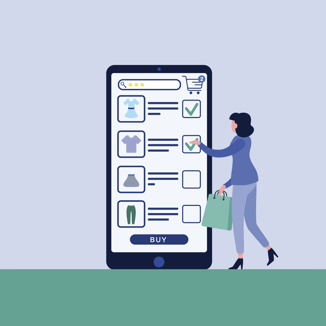In recent years, there has been a significant shift in the way companies collect and utilize consumer data. Businesses are facing greater scrutiny over data privacy and security. Therefore, they seek alternative methods to obtain information that does not rely on third-party sources.
One solution that has gained traction is zero-party data. In this blog post, we'll explore what zero-party data is and how it's impacting the retail industry.
Types of Data That Drive Personalized Experiences
Zero-Party Data
Zero-party data is customer data that consumers willingly and proactively share with businesses. Unlike traditional first-party data, which a company collects through customer interactions and transactions, the customer voluntarily provides zero-party data. This can include preferences, interests, purchase intentions, and more.
This data is often collected through surveys, quizzes, and other interactive experiences that provide value to the customer in exchange for their information. A store may offer a personalized product recommendation based on the customer's style preferences or a coupon code. In exchange, the retailer gains the customer’s email address. This information allows customers to receive a better shopping experience tailored to their needs and interests.
First-Party Data
First-party data is the data that a company collects directly from its customers, visitors, or users. This data comes from interactions with the company's website, mobile app, or other touch points, such as customer service or purchase transactions. First-party data may include browsing behavior, purchase history, and user demographics.
Second-Party Data
Second-party data is another company's first-party data acquired directly from that company through a partnership or agreement. This data is still considered high-quality, as it comes from a direct source, but it might not be as relevant or accurate as first-party data since it originates from a different context.
Third-Party Data
Third-party data is aggregated and collected from multiple sources by a third-party company. The information is then sold to other organizations. It is typically used to enrich existing first and second-party data, providing a broader context for analysis and targeting.
Third-party data can be less reliable than first and second-party data. It originates from various sources, and users may have yet to consent. However, third-party data can be less reliable than first and second-party data due to its origin from multiple sources and the potential lack of direct user consent.
Why is Zero-Party Data Important?
The increasing importance of zero-party data is linked to the decline in third-party cookies. Web browsers and governments are introducing stricter privacy regulations and restrictions on data collection practices. This results in the gradual phasing out of third-party cookies.
With high-profile data breaches and scandals making headlines, consumers are increasingly wary of sharing their personal information with companies. A recent survey found that 82% of consumers are concerned about how companies use and gather their data.
Data is power, and consumers are more likely to trust brands that give them control over their information. Sharing information proactively leads to more personalized customer experiences, which improves satisfaction and loyalty.
In addition, zero-party data can also provide businesses with valuable insights into customer behavior and preferences. Companies can gain a more accurate and comprehensive understanding of their target audience by directly asking customers for information. This can help companies to improve their marketing strategies, product development, and overall customer experience.
Benefits of Deploying a Zero-Party Data Initiative
Enhanced personalization - Zero-party data enables marketers to deliver highly personalized content, offers, and experiences based on user's preferences, interests, and needs. The benefits of a well-executed content strategy include improved user engagement, customer satisfaction, and increased conversion rates.
Privacy compliance - As privacy regulations become more stringent, organizations must adopt data collection practices that respect user privacy and comply with relevant laws. Zero-party data is collected with users' explicit consent, making it more compliant with privacy regulations such as GDPR and CCPA.
Increased trust and loyalty - Organizations can build customer trust by responsibly collecting and utilizing zero-party data. This trust can translate into high brand loyalty, repeat business, and positive word-of-mouth marketing.
Higher quality data - Zero-party data is typically more accurate and relevant than third-party data because users willingly provide it and reflect their current preferences and intentions. This higher-quality data enables better targeting, segmentation, and personalization efforts.
Reduced reliance on third-party data - As third-party cookies phase out, organizations must find alternative data sources to understand and engage their target audience. A zero-party data initiative can provide a valuable, consent-driven alternative to third-party data, helping to maintain effective marketing campaigns without infringing on user privacy.
Better decision-making - Access to accurate and up-to-date user data allows organizations to make more informed decisions regarding product development, sales strategies, and marketing campaigns. This ultimately leads to improved results and return on investment.
Enhanced customer profiles - Combining zero-party data with first-party data can help create more comprehensive customer profiles, giving organizations a better understanding of their customers' needs, preferences, and behaviors. Customer insights gained from deeper analysis help drive strategies and enhance the customer experience.
Improved conversion rates - Organizations can generate more high-quality conversions by using zero-party data to create targeted and personalized marketing campaigns. This results in a more effective sales funnel and improved revenue generation.
How to Implement a Zero-Party Data Strategy
Creating a zero-party data strategy involves planning and implementing methods to collect, store, and utilize data provided willingly and proactively by your users. Here are some steps to develop an effective zero-party data strategy:
Assess your data needs - Begin by identifying the specific data points that are most valuable and relevant for your marketing, sales, or product development efforts. This will help you determine the type of zero-party data you want to collect and focus on obtaining.
Create compelling touch points - Design engaging, user-friendly touch points that encourage users to share their information willingly. These touch points can include surveys, preference centers, polls, quizzes, and gated content. Offer incentives, exclusive content, or personalized experiences to increase participation in exchange for user data.
Be transparent and prioritize privacy - Communicate how you use the user's data and comply with relevant privacy regulations. Be transparent about your data collection practices and give users control over their data. This includes the ability to update or delete their information quickly.
Integrate with your marketing technology stack - Ensure that your zero-party data can be easily integrated with your existing marketing technology tools, such as customer relationship management (CRM) systems, marketing automation platforms, and data management platforms (DMPs). This will allow you to leverage zero-party data for segmentation, targeting, and personalization across your marketing channels.
Analyze and optimize data collection - Regularly analyze the effectiveness of your zero-party data collection methods and optimize them based on the insights gained. Experiment with different touch points, content formats, and incentives to identify what works best for your target audience.
Personalize experiences - Use the zero-party data you've collected to deliver personalized content, offers, and experiences to your users. Personalization based on accurate and up-to-date user preferences will lead to better engagement, satisfaction, and conversions.
Monitor and maintain data quality - Zero-party data can change over time as user preferences and needs evolve. Regularly update and maintain your zero-party data to ensure its accuracy and relevance. Encourage users to update their preferences and offer easy-to-use tools for doing so.
Measure success - Define key performance indicators (KPIs) to measure the effectiveness of your zero-party data strategy. Monitor the impact on user engagement, lead quality, conversion rates, and other relevant metrics. Then adjust your plan as needed to achieve your goals.
By following these steps, you can develop a zero-party data strategy to better understand and engage with your users while respecting their privacy and complying with relevant regulations.
First Insight helps businesses build achievable plans and increase forecast accuracy using customer-driven insights. InsightSUITE empowers retailers and brands worldwide with zero-party, actionable consumer insights to make product, pricing, and marketing decisions that drive results.
Companies can enhance their competitive position by collecting and analyzing customer data while reducing risk. With zero-party data, retailers can better understand consumer preferences and trends and identify new business opportunities. Learn more about how our Insight Strategy & Planning Solutions can inform your strategy today.
















